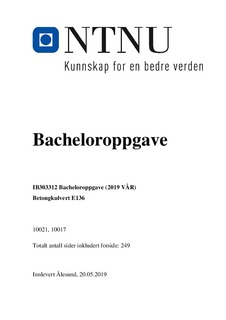| dc.contributor.advisor | Normann, Kristian | |
| dc.contributor.author | Skavhellen, Thea Vestrheim | |
| dc.contributor.author | Andersen, Sofie | |
| dc.date.accessioned | 2019-09-06T14:10:21Z | |
| dc.date.available | 2019-09-06T14:10:21Z | |
| dc.date.issued | 2019 | |
| dc.identifier.uri | http://hdl.handle.net/11250/2613472 | |
| dc.description.abstract | Denne rapporten omhandler et dimensjoneringsgrunnlag for en betongkulvert på veistrekningen E136 gjennom Veblungsnes, i Rauma kommune. Oppgaven er gitt som en bacheloroppgave og løst i samarbeid med Staten vegvesen.
Vegstrekninger har i dag en flaskehals med dårlig kurvatur og er en relativ smal veg. Dette har ført til trafikkulykker og deler av bebyggelsen er plaget av for høyt støynivå, veien er ikke innenfor kravene som stilles. Veien skal derfor senkes ned i en betongkulvert. Ved utforming av denne betongkulverten er det utfordringer i forhold til høy grunnvannstand, ulike grunnforhold og overliggende trafikk på deler av kulverten.
Vi tar utgangspunkt i tegninger med dimensjoner mottatt fra Statens vegvesen for å kunne besvare problemstillingen. Kulverten skal dimensjoneres med utgangspunkt i Norsk standard med nasjonale tillegg og Statens vegvesen sine håndbøker og retningslinjer. Hjelpemidler vi har benyttet oss av for å løse oppgaven er beregningsprogrammene Fem Design og Eurocode Express. Håndberegninger basert på metoder hentet fra “Betongkonstruksjoner” av Sørensen, samt Revit som vi har benyttet for å lage detaljtegninger.
I resultatene er vi kommet frem til moment-, skjær-, og aksialdiagrammer, mengde armering og gjennomført kontroll for ulike deformasjoner. Dette har gitt oss en bedre forståelse for sammenhengen mellom de ulike fagområdene konstruksjon, geoteknikk og veg. Rapporten er et beregningsgrunnlag for videre arbeid ved kulverten. | |
| dc.description.abstract | This report is a calculation basis for a concrete culvert on the road stretch E136 through Veblungsnes, in Rauma municipality. The assignment is given as a bachelor's thesis and solved in collaboration with the Norwegian Public Roads Administration.
The road section today has a bottleneck with poor curvature and are a relatively narrow road. This has led to traffic accidents and parts of the buildings in the area are plagued by excessive noise levels, the road is not within the requirements set. It is proposed to lower the road into a concrete culvert. When designing this concrete culvert, there are challenges in relation too high groundwater levels, different ground conditions and overlying traffic on parts of the culvert.
We have used drawings with dimensions received from the Norwegian Public Roads Administration in order to be able to answer the questions. The culvert is designed based on the Norwegian standard with national additions and the Norwegian Public Roads Administration's manuals and guidelines. Aids we have used to solve the task are the calculation programs Fem Design and Eurocode Express. Hand calculations based on methods derived from "Betongkonstruksjoner" by Sørensen, as well as Revit that we have used to make detail drawings.
In the results we have produced diagrams for torque, shear, and axial forces, calculated the amount of reinforcement and checked for different deformations. This has given us a better understanding of the connection between the various disciplines of construction, geotechnics and road. The report is a basis for calculation for further work at the culvert. | |
| dc.language | nob | |
| dc.publisher | NTNU | |
| dc.title | Betongkulvert E136 | |
| dc.type | Bachelor thesis | |
